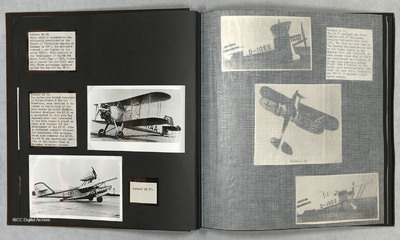Heinkel He 49, He 50 and He 57
Title
Heinkel He 49, He 50 and He 57
Description
Photo 1 of an He 49 is missing.
Photo 2 is a side view of an He 50.
Photo 3 is a single engined seaplane, He 57, seen here starboard side on the ground.
Photo 2 is a side view of an He 50.
Photo 3 is a single engined seaplane, He 57, seen here starboard side on the ground.
Coverage
Language
Type
Format
Three b/w photographs on an album page
Publisher
Rights
This content is available under a CC BY-NC 4.0 International license (Creative Commons Attribution-NonCommercial 4.0). It has been published ‘as is’ and may contain inaccuracies or culturally inappropriate references that do not necessarily reflect the official policy or position of the University of Lincoln or the International Bomber Command Centre. For more information, visit https://creativecommons.org/licenses/by-nc/4.0/ and https://ibccdigitalarchive.lincoln.ac.uk/omeka/legal.
Identifier
PThomasAF20070007
Transcription
Heinkel HE 49.
While still a clandestine arm, officially prohibited by the Treaty of Versailles imposed on Germany in 1919, the Luftwaffe ordered a new fighter in the early 1930’s. This resulted in the development of the HE 49A which first flew in 1932, listed as a trainer for the Civil market. Three prototypes appeared paving the way for the HE 51.
[Photograph]
Heinkel HE 50.
The vuctorious [sic] German Campaigns in Poland, France & the Low Countries, were destined to be linked in the history of the dive bomber in Aerial Warfare. Heinkel developed the HE 50 as a specialist in this role The Japanese were very interested in the dive bomber & placed an order with Heinkel for the development of the HE 50 able to withstand catapult stresses for operations from warships. China also ordered the HE 50. The HE 50 was operational until 1944 in the Baltic flown by Estonian volunteer aircrew.
[Photograph]
[Photograph]
Heinkel HE 57.
While still a clandestine arm, officially prohibited by the Treaty of Versailles imposed on Germany in 1919, the Luftwaffe ordered a new fighter in the early 1930’s. This resulted in the development of the HE 49A which first flew in 1932, listed as a trainer for the Civil market. Three prototypes appeared paving the way for the HE 51.
[Photograph]
Heinkel HE 50.
The vuctorious [sic] German Campaigns in Poland, France & the Low Countries, were destined to be linked in the history of the dive bomber in Aerial Warfare. Heinkel developed the HE 50 as a specialist in this role The Japanese were very interested in the dive bomber & placed an order with Heinkel for the development of the HE 50 able to withstand catapult stresses for operations from warships. China also ordered the HE 50. The HE 50 was operational until 1944 in the Baltic flown by Estonian volunteer aircrew.
[Photograph]
[Photograph]
Heinkel HE 57.
Collection
Citation
“Heinkel He 49, He 50 and He 57,” IBCC Digital Archive, accessed November 13, 2024, https://ibccdigitalarchive.lincoln.ac.uk/omeka/collections/document/23196.
Item Relations
This item has no relations.

